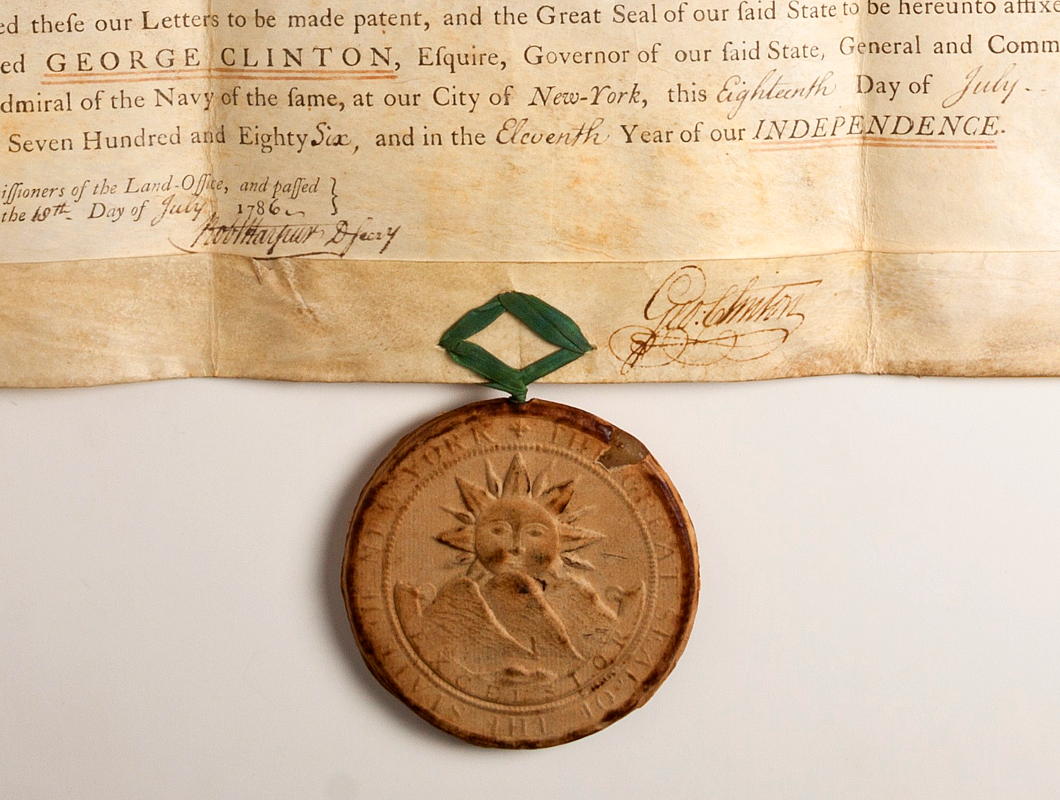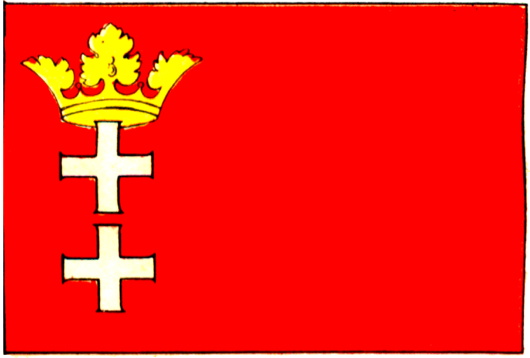Heraldry
About Andrew Cusack
 Writer, web designer, etc.; born in New York; educated in Argentina, Scotland, and South Africa; now based in London.
Writer, web designer, etc.; born in New York; educated in Argentina, Scotland, and South Africa; now based in London. read more
News
Blogs
Reviews & Periodicals
Arts & Design
World
France
Mitteleuropa
Knickerbockers
Argentina
The Levant
Africa
Cape of Good Hope
Netherlands
Scandinavia
Québec
India
Muscovy
Germany
Academica
Spooks’ Crown

The Security Service, better known as “MI5” has changed its badge to incorporate the change from the St Edward’s Crown to the Tudor Crown that King Charles III has adopted.
The badge was designed by Lt-Col Rodney Dennys who himself had worked for the Security Service’s more glamorous rival, the Secret Intelligence Service (MI6). Dennys had started out in the intelligence game at the Foreign Office and was posted to the Hague before the war. When the Germans rolled in he was on one of the last boats to make it to Britain.
The MI5 emblem was approved by Garter King of Arms in 1981 but (like MI6) the Security Service was still so secret that it did not officially exist, so it was added to the secret roll of arms kept under lock and key in the depth of the heralds’ college in the City of London.
In 1993, after the Service’s existence was formally acknowledged, the badge became known and a flag bearing it often flies from the top of Thames House.

GCHQ has likewise adopted the Tudor Crown, but SIS has not publicly acknowledged any official emblem. (Perhaps it has its own entry in the heralds’ secret roll?) As such, MI6 uses a government version of the royal coat of arms, but theirs has yet to swap crowns.

Letters Patent
In the collections of the American Numismatic Society — formerly resident at Audubon Terrace but lately removed further south to Varick Street — there is a fine example of letters patent from the year 1786, signed by Governor George Clinton and validated by the Great Seal of the State of New York.
Letters patent are a form of open declaration by a sovereign or head of state, usually conferring the grant of an office, title, land, or rights. The most well-known patents are those covering the intellectual property of scientific inventions, issued by bodies like the United States Patent and Trademark Office or the UK’s Intellectual Property Office.
These particular letters patent deal with a land grant made to one Joshua Mersereau. From a family of Huguenot extraction, Mersereau studied at King’s College and ran a tavern on Staten Island. When America’s first civil war erupted in 1775, he joined the rebels and was commissioned a major in the “patriot” forces. He also represented his island’s coterminous County of Richmond in the rebel Provincial Congress that convened at Kingston.
Alongside other members of his family, Major Mersereau organised an effective spy ring that gathered useful operational intelligence on the movements of British and loyal American forces in the Hudson Valley, Staten Island, and neighbouring parts of New Jersey. It was likely for that contribution, as well as for his political influence more broadly, that this grant of land was made.
A Realm That Never Was
The United Kingdom of the Rio de la Plata, Chile, and Peru
If we give in to temptation and attempt to see things without the benefit of hindsight, Brazil’s path to independence as a monarchy is less surprising than the fact that Argentina didn’t pursue a similar trajectory. After all: Argentina’s ‘Liberator’, José de San Martín, was himself a monarchist, as was Manuel Belgrano.
Belgrano’s project was to unite the Provinces of the River Plate with Chile and the old viceroyalty of Peru in one united kingdom under a Borbón king. This was to be the Infante Don Francisco de Paula, the youngest son of Charles IV of Spain, but the Spanish king ardently refused to yield his throne’s sovereignty over the new world, nor to allow any of his offspring to take part in the various projects for local monarchies.
When that failed, Belgrano proposed to the Congress of Tucumán that they crown an Incan as king. San Martín, Güemes, and others supported this, but Buenos Aires resisted the plan. They proposed instead to crown Don Sebastián, a Spanish prince living in Rio de Janeiro with his maternal grandfather, King João VI of Portugal.
João thought the scheme would end up injurious to Portugal’s interests and so put the kibosh on it.
And don’t get us started on Carlotism, which was a whole ’nother pile of tricks.
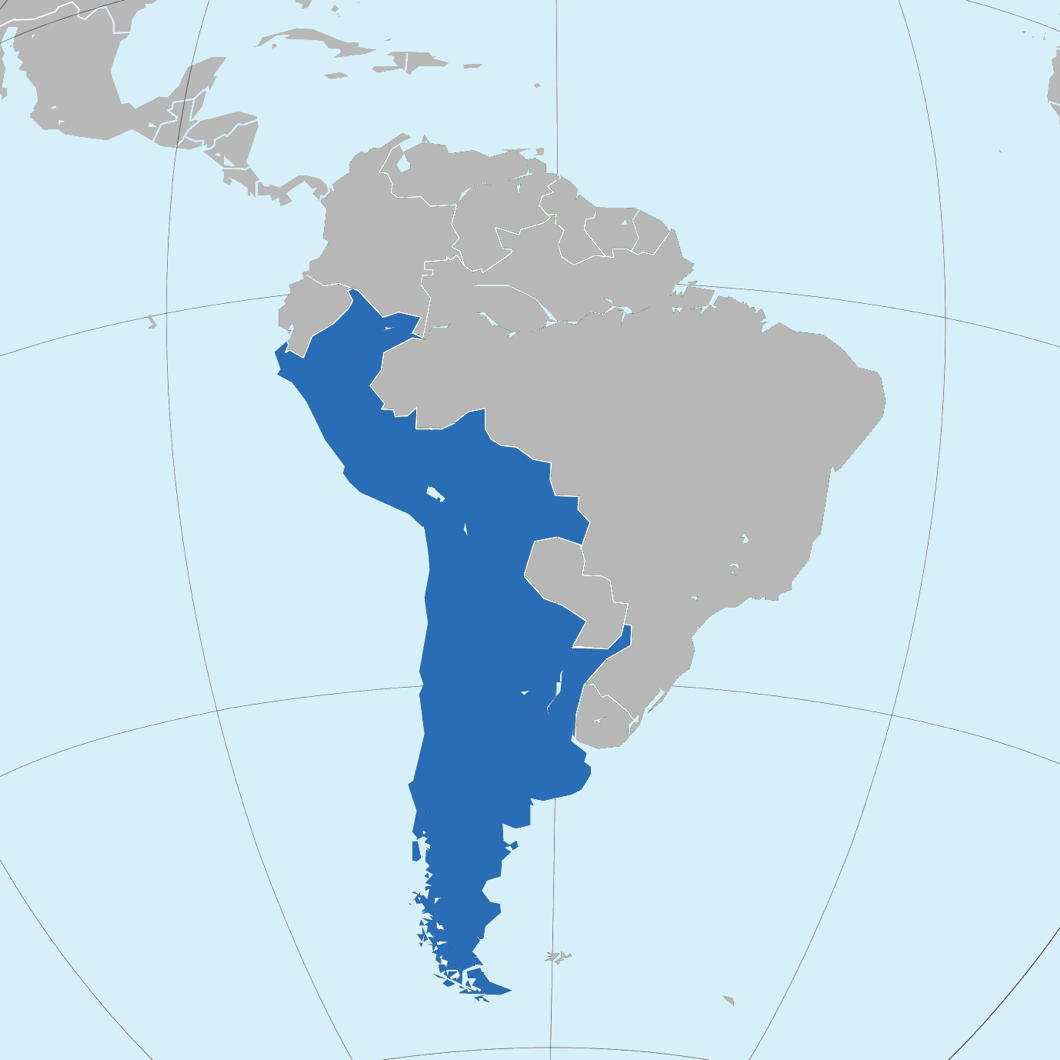
Belgrano’s monarchic project in its 1815 iteration was to unite the provinces of the River Plate with Chile and the old viceroyalty of Peru to create a single realm out of these Spanish-speaking territories.
He even drafted a constitution for the United Kingdom of the Rio de la Plata, Chile, and Peru, which is rudimentarily translated into English below. This even went so far as to specify the coat of arms and flag of the kingdom.
The best history covering these unconsummated plans remains Bernado Lozier Almazán’s 2011 book Proyectos monárquicos en el Río de la Plata 1808-1825: Los reyes que no fueron which sadly has not yet been translated into English.
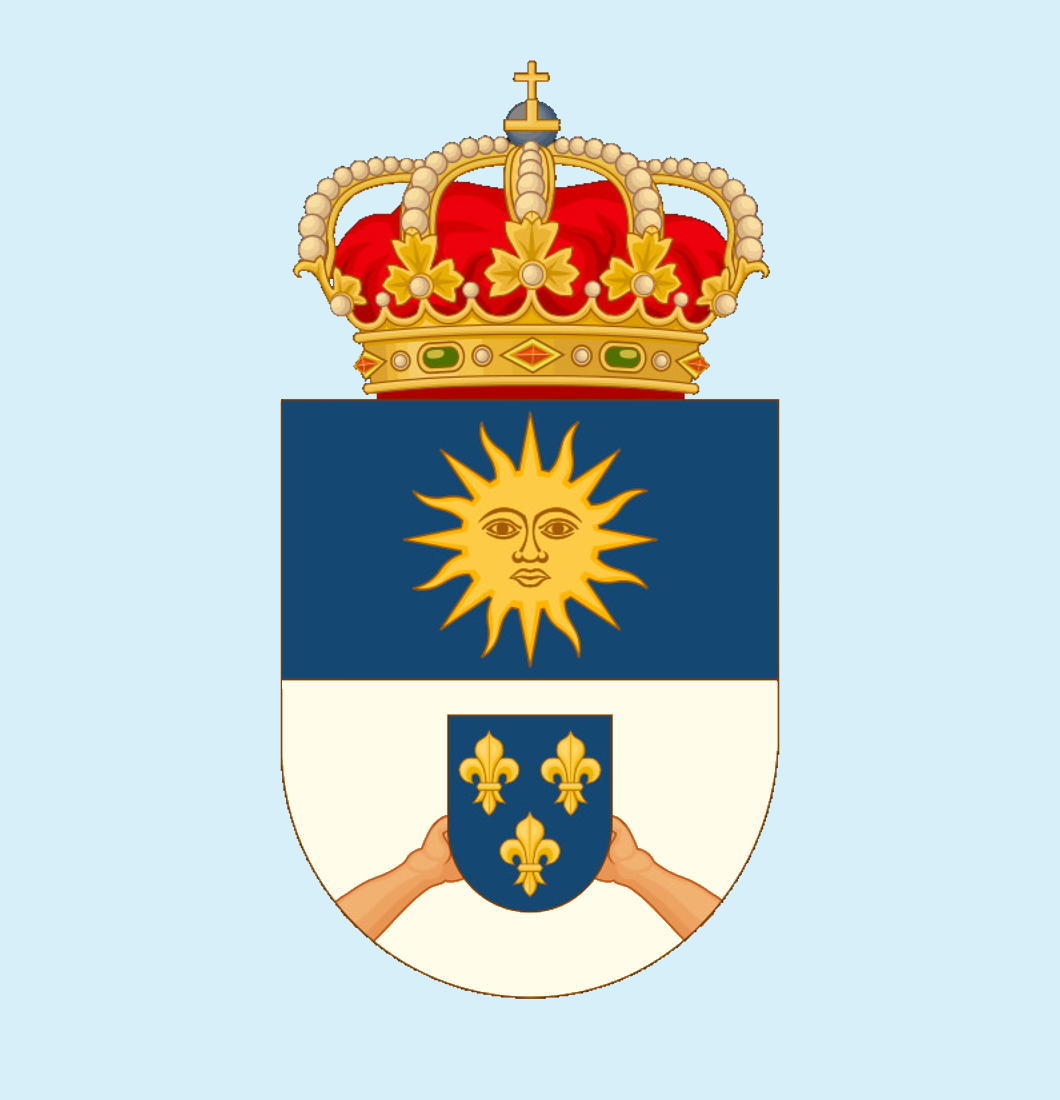
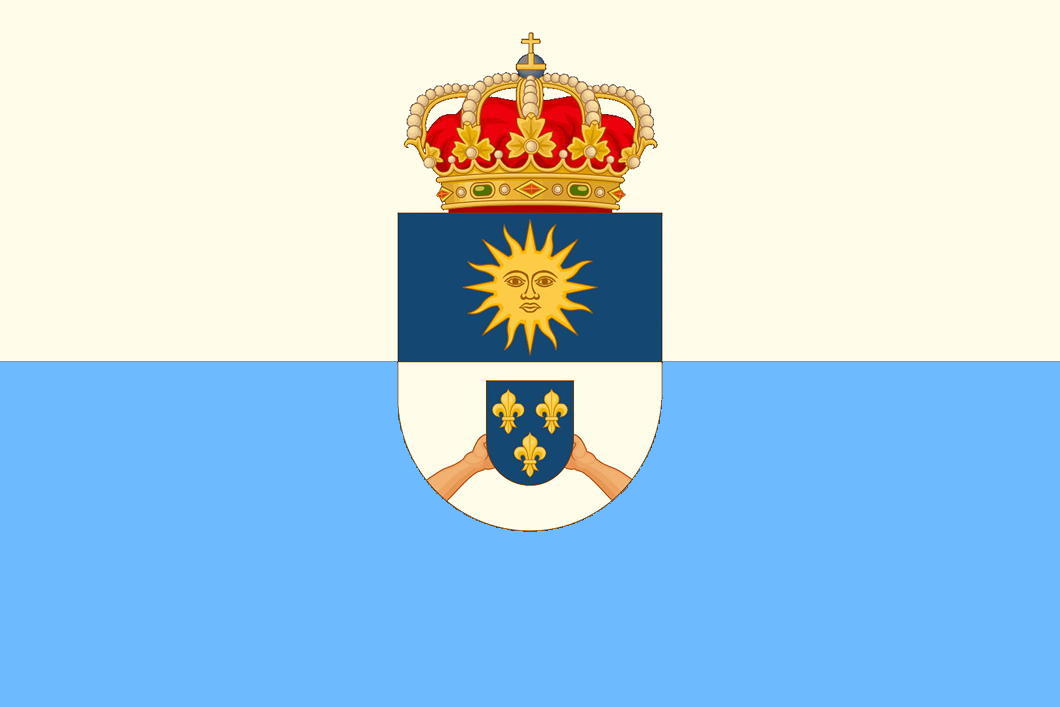
Article 1 — The new Monarchy of South America will have the name of the United Kingdom of the Río de la Plata, Peru, and Chile; its coat of arms will be a shield that will be divided into blue and silver fields; In the blue that will occupy the upper part, the image of the Sun will be placed, and in Silver two arms with their hands that will hold the three flowers of the emblems of My Royal Family; surmounted by the Royal Crown, and will have as supporters a tiger and a llama. Its flag will be white and light blue.
Article 2 — The Crown will be hereditary in order of proximity in the lines of agnation and cognation.
Article 3 — If, God forbid, the current King dies without succession, his rights will revert to me so that with the agreement and consent of the Legislative Body I choose another Sovereign from my Royal Family; but, if I no longer exist, said Chambers will have the power to elect one of the princes of my Blood Royal as their King.
Article 4 — The person of the King is inviolable and sacred. The Ministers are responsible to him. The King will command the forces of sea and land; he will declare war, he will make peace; he will make treaties of alliance and trade; he will distribute all the offices, he will be in charge of the public administration, the execution of the laws, and the security of the State to whose objects he will give the necessary orders and regulations.
Article 5 — The King will name all the nobility; he will grant all the dignities, he will be able to vary them and grant them for life, or make them hereditary. The King may forgive offences, commute sentences, or dispense them in the cases that the law grants him.
Article 6 — The nobility will be hereditary in the same terms as the Crown; it will be distinguished precisely in three grades, and cannot be extended to more: the first grade will be that of Duke, the second of Count and the third of Marquis; the nobles will be judged by only those of their class, they will have part in the formation of the laws, they will be able to be Deputies of the Towns and they will enjoy the honours and privileges that the law or the King grants them; but they may not be exempted from the charges and services of the State. Any individual of the State of any class and condition may opt for the nobility for their services, for their talents, or for their virtues. The first number of the nobility will be agreed by the King and Representative and at any other time by the Legislative Body.
The Legislative Body
Article 7 — The Legislative Body will be composed of the King, the Nobility, and Representation of the Commons.
The Upper Chamber will be formed: the first part by all the Dukes, whose right is declared inseparable from their dignity; the third part of the Counts, by election among themselves, presided over by a King’s Commissioner; the fourth part of the Marquises, elected on their own terms; and the fifth part of the Bishops of the Kingdom, elected the first time by the King, being in charge of it and the other Chamber, to establish the bases for the election of this body for the future.
Article 8 — The Second Chamber will be made up of the Deputies of the Peoples, who will be elected for the first time in the customary terms that allow less play to the parties, and will consult the greatest opinion, it being an essential charge to the Legislative Body to establish for the latter the most adequate and precise laws.
Article 9 — The power to propose the law will be common to the King and both Chambers; the order of the proposition will be from the King to the First Chamber, and from this to the King, and from the Second to the First, in the event that a proposal is not admitted by its immediate chamber, it cannot go to the third, nor be repeated until another session. Every law will be the result of the plurality of both Chambers, and secondly of the King; the sanction and promulgation of the law will be exclusively his.
The chambers may not join or dissolve without the express order of the King. He will be able to extend them for as long as he deems it necessary, and dissolve that of the Deputies when he deems it appropriate.
Article 10 — The designation of the King’s income, his Royal House and Family, the expenses of his Minister and Cabinet, the civil list, the military, and extraordinary expenses will be exclusively agreed by both Chambers, to which in the same way belongs to the arrangement and imposition of rights and contributions.
The Ministry
Article 11 — No order of the King without the authorisation of his corresponding Minister will be fulfilled; the Ministers will have the power to propose to both Chambers what they deem appropriate, and enter any of them to report what they deem appropriate; the Ministers will indispensably be Members of the High Court, and only by it may they be judged. The Ministers may not be accused except for treason or extortion, the accusation will not be admissible unless it is made by the plurality of one or another Chamber; the Minister of Finance will present to both Chambers for their knowledge and approval the accounts of the previous year.
The Judiciary
Article 12 — The judges will be appointed by the King; they will be perpetual and independent in their administration, only in the case of notorious injustice or ruling can they be accused before the Upper Chamber who will judge them independently of the King, who will protect and execute their decisions in this part; The judges of the fact will be established, called the jury in the most adaptable way to the situation of the Towns.
The Commonalty of the Nation
Article 13 — In addition to the proportionate and uniform distribution of all charges and services of the State, the option to nobility, jobs and dignities, and the common competition and subjection to the law; The Nation will enjoy, with the inalienable right to property, freedom of worship and conscience, freedom of the press, the inviolability of property, and individual security in the terms clearly and precisely agreed upon by the Legislative Power.
Those elected by the nobility, clergy, and commonalty will last six years, starting to renew the first elected by half every three years: The Common Deputies may not be executed, persecuted, or tried during their commission, except in cases that the law designated and by the Chamber itself to which they belong.
Bronxville’s Coat of Arms
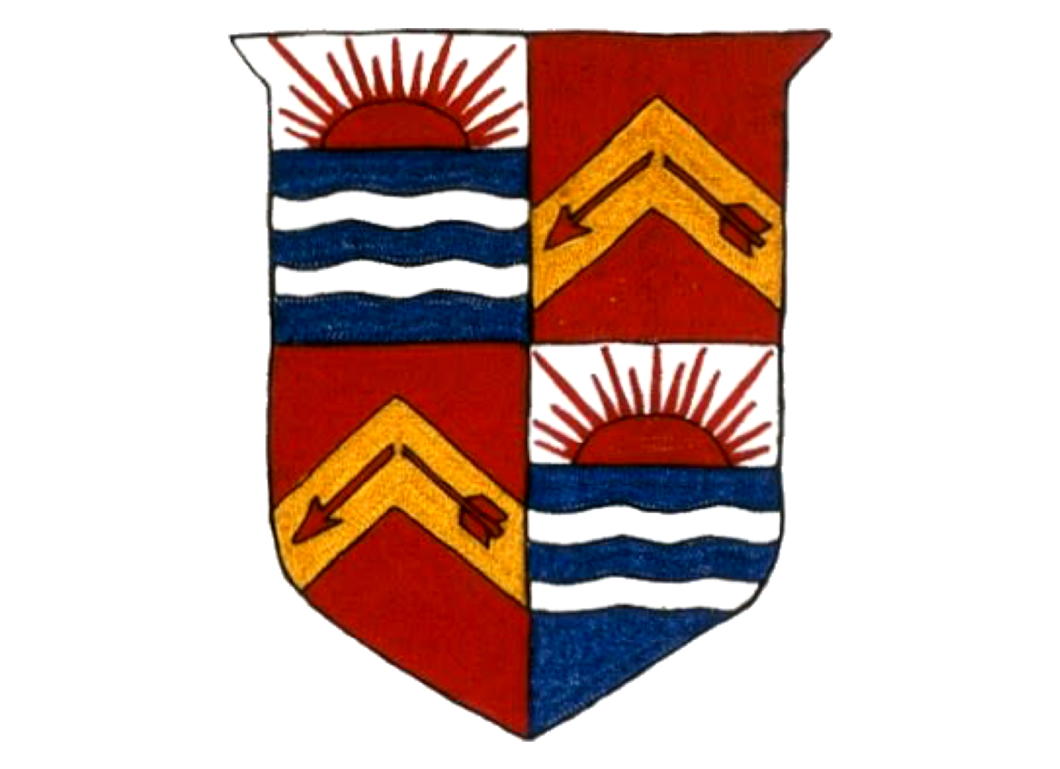
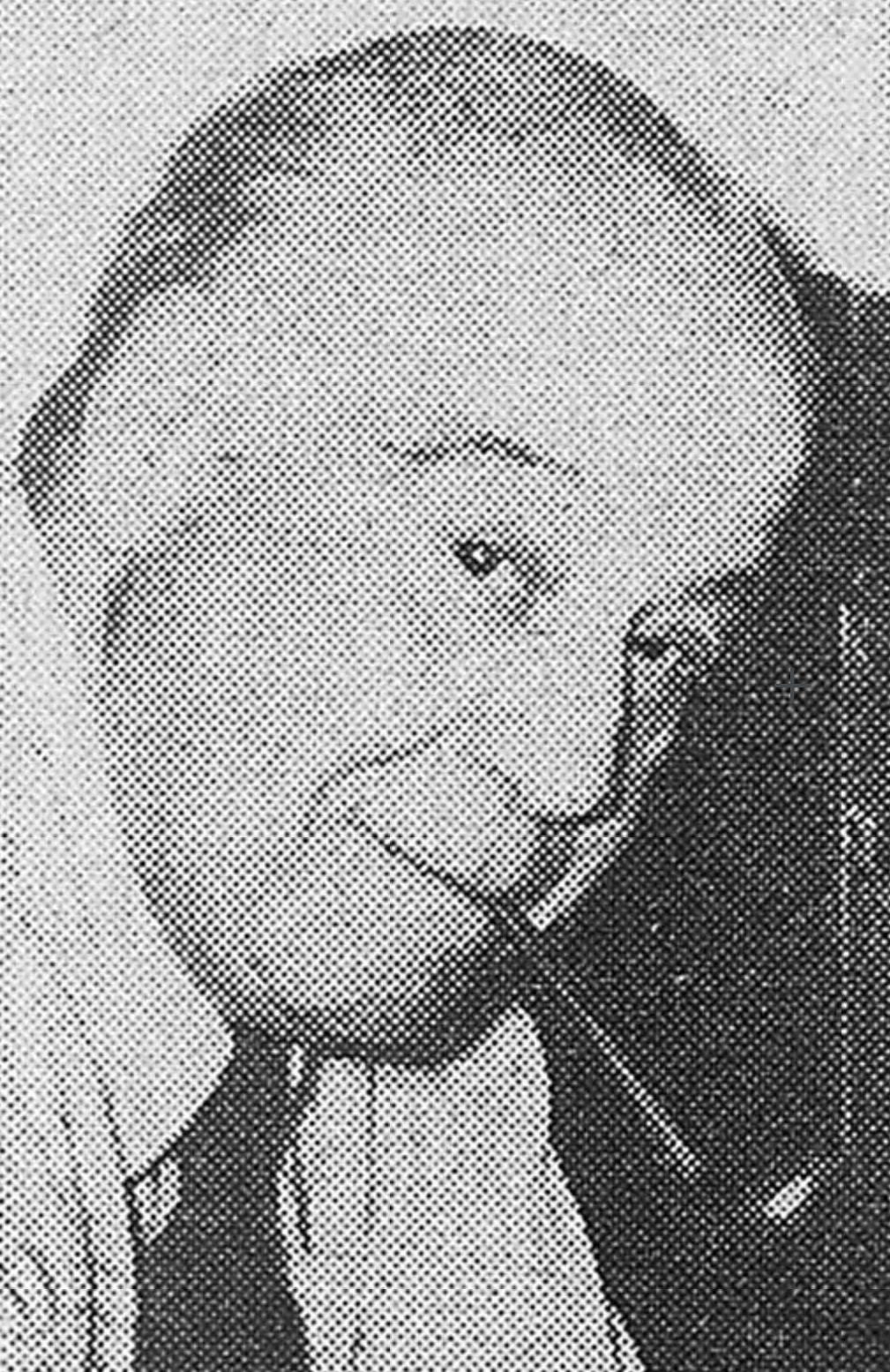 The coat of arms of the Village of Bronxville is a surprisingly handsome design, for which we can thank a gentleman named Lt. Col. Harrison Wright.
The coat of arms of the Village of Bronxville is a surprisingly handsome design, for which we can thank a gentleman named Lt. Col. Harrison Wright.
Known to most as Hal, Wright (1887–1966) was one of those citizens who seemed to have had endless time to devote to those around them. In the Great War he served in a variety of roles and had the pleasure of personally delivering a Packard automobile to General Pershing.
He helped coordinate the village police when its captain’s ill health forced an unexpected retirement and was an active member of the American Legion post.
Wright was also Scoutmaster of Troop 1 and served as the local District Commissioner for the Boy Scouts. In that role he had under his purview a young scout from my old troop — Troop 2, Bronxville — named Jack Kennedy.
During the Second World War, Wright deployed his significant logistical expertise as an officer at the U.S. Army’s New York Port of Embarkation but, with his artistic skills and heraldic interest, he also found time in 1942 to design Bronxville’s coat of arms. (more…)
Arms and the Man
GOVERNOR CUOMO — is there anything that man won’t fiddle with? Is there nothing that can escape his grasping hands? Are we to suffer from the incessant interference of this megalomaniac forever?
The latest trespass His Excellency has committed is to encroach upon the very sacred symbols of the Empire State itself: our beloved coat of arms — and, by extension, the flag which also bears it aloft.
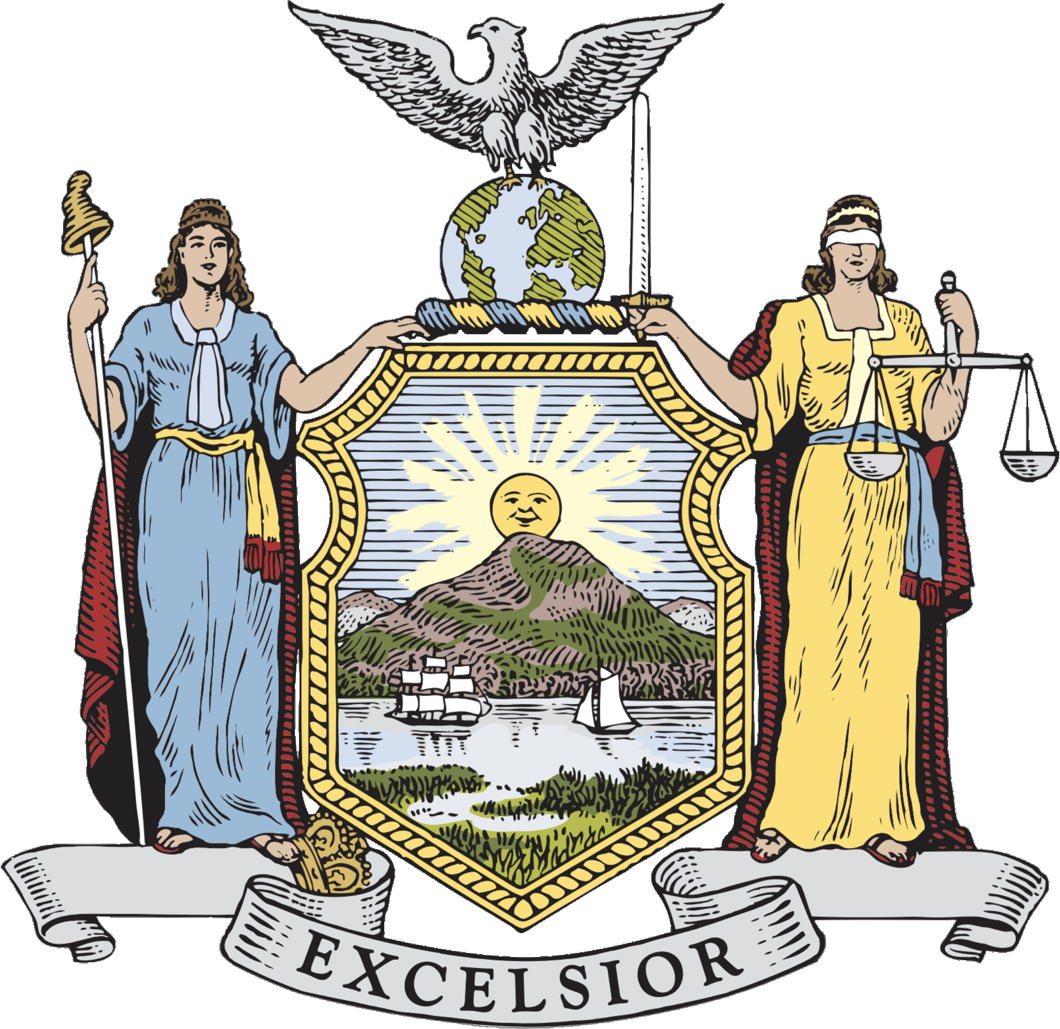
Gaze upon its beauty, for you will see it fade. Azure, in a landscape, the sun in fess, rising in splendour or, behind a range of three mountains, the middle one the highest; in base a ship and sloop under sail, passing and about to meet on a river.
This beautiful device was adopted by the very first Assembly and Senate of the State of New York back in 1778, having been designed a year earlier. It has remained substantially unchanged since the 1880s until Governor Cuomo in one of his fits of fancy decided to sneak a change via the state budget, of all things.
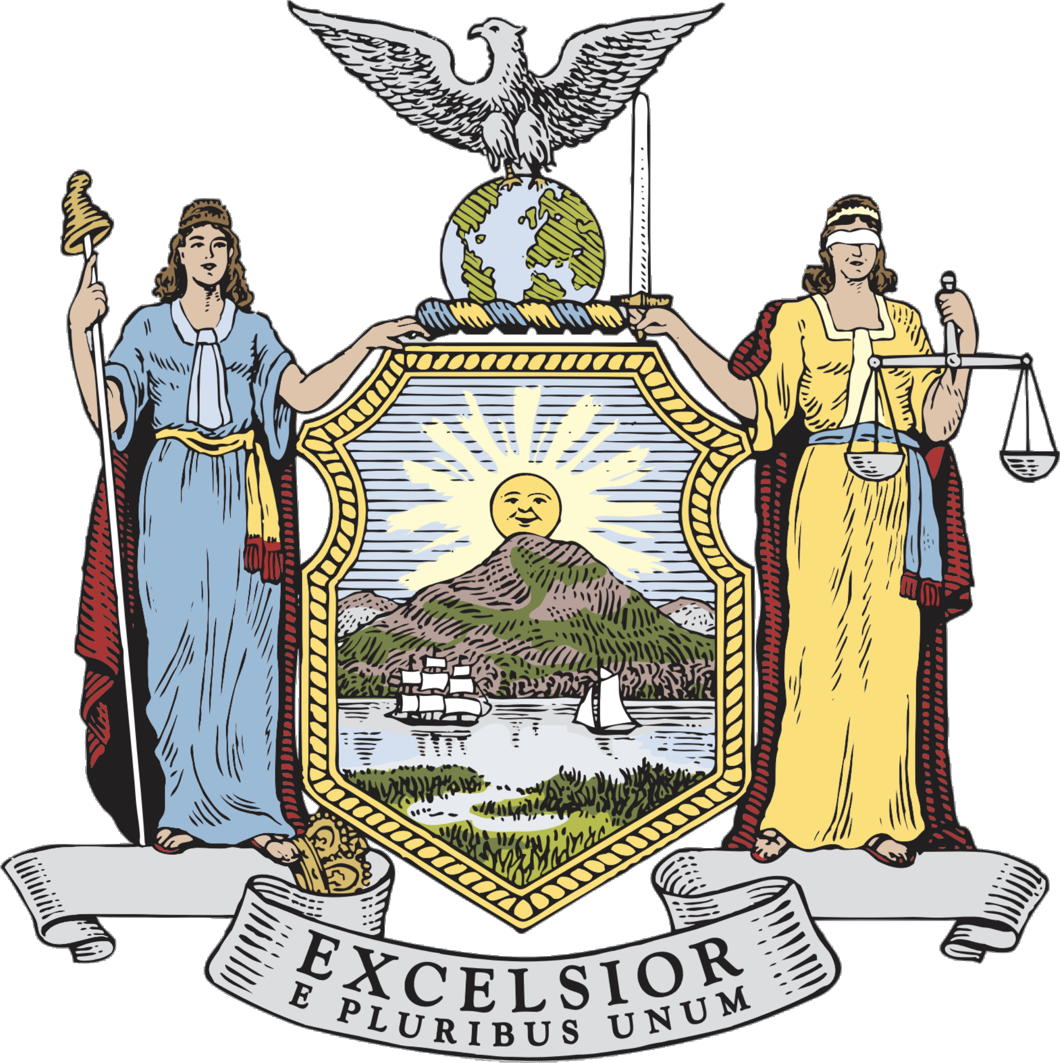
“In this term of turmoil, let New York state remind the nation of who we are,” Governor Cuomo said in his State of the State address in January of this year. “Let’s add ‘E pluribus unum’ to the seal of our state and proclaim at this time the simple truth that without unity, we are nothing.”
Why the national motto should be interjected into the state flag when we have our own motto is beyond me. Rather than introduce a bill that would allow an open debate on the matter, the Governor decided to sneak it into the state budget. This passed in April, so the coat of arms, great seal, and flag of the state of New York have all now been altered to include the superfluous words.
That said, I have a sneaking suspicion the change might be honoured more in the breach than in the observance. Flag companies doubtless have a large back supply of pre-Cuomo flags to shift and customers are rarely up to date on matters vexillological and heraldic. I suspect that the next time you float down Park Avenue and see the giant banners fluttering from corporate headquarters very few will have updated their state flag.
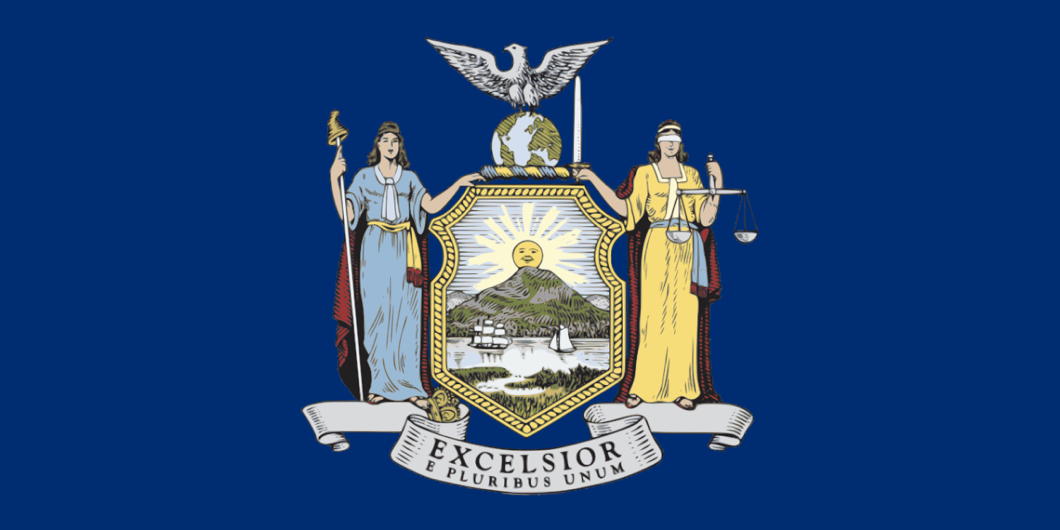
The Port of London
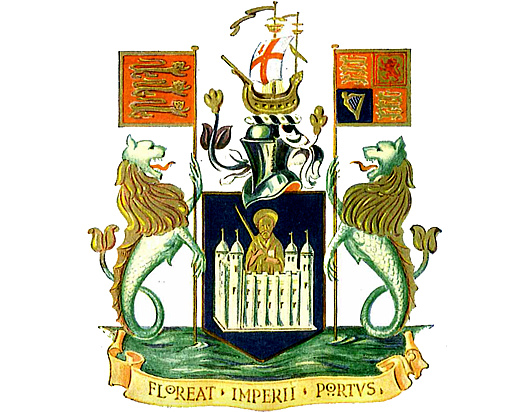
Officially there are or have been various Londons: first the City of London, founded in AD 43 and a mere square mile to this day, then the County of London created in 1889, and the creature called Greater London has also existed in varying shapes and forms since 1965.
But there is also the Port of London, which has existed since the first century and was once the busiest port in the world, bringing the riches of empire to the metropolis from the four corners of the earth.
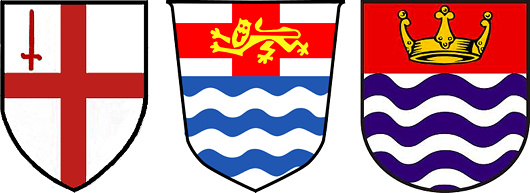
The arms of the City of London, London County Council, and Greater London Council.
All these Londons, of course, have over the centuries been granted or assumed their own coats of arms as heraldic emblems of their importance. The Port of London Authority was created in 1908 by an Act of Parliament which some scholars argue is the first law in the world mandating codetermination or workers’ participation in the board.
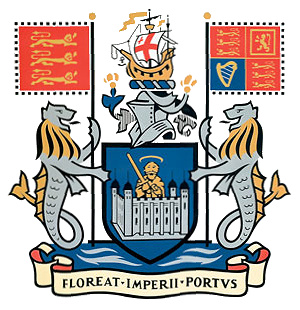 Its coat of arms was granted a year later in 1909 and features on its shield Saint Paul, the patron saint of London bearing his usual sword, issuing forth from the Tower of London.
Its coat of arms was granted a year later in 1909 and features on its shield Saint Paul, the patron saint of London bearing his usual sword, issuing forth from the Tower of London.
The crest above the shield is a galley bearing on its mainsail the arms of the City of London — the Lord Mayor is ex officio the Admiral of the Port of London.
Sea lions act as supporters, also bearing standards of the royal arms of England and of the United Kingdom, while the motto proclaims in Latin May the Port of the Empire Flourish.
For proper heraldry nerds, the arms are blasoned:
Shield: Azure, issuing from a castle argent, a demi-man vested, holding in the dexter hand a drawn sword, and in the sinister a scroll Or, the one representing the Tower of London, the other the figure of St Paul, the patron saint of London.
Crest: On a wreath of the colours, an ancient ship Or, the main sail charged with the arms of the City of London.
Supporters: On either side a sea-lion argent, crined, finned and tufted or, issuing from waves of the sea proper, that to the sinister grasping the banner of King Edward II; the to the sinister the banner of King Edward VII.
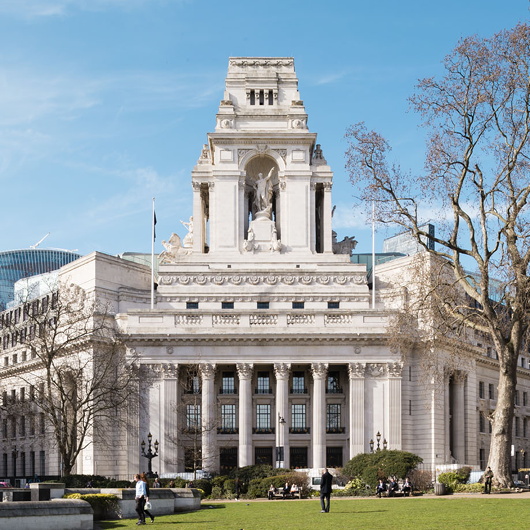
Befitting the Port of the Empire, the Authority built a grandiose headquarters at 10 Trinity Square, overlooking the Tower of London featured in its coat of arms.
The PLA moved out ages ago and the building is now a hotel, but it often features in films and television as a government (most prominently in the 2012 James Bond film ‘Skyfall’).
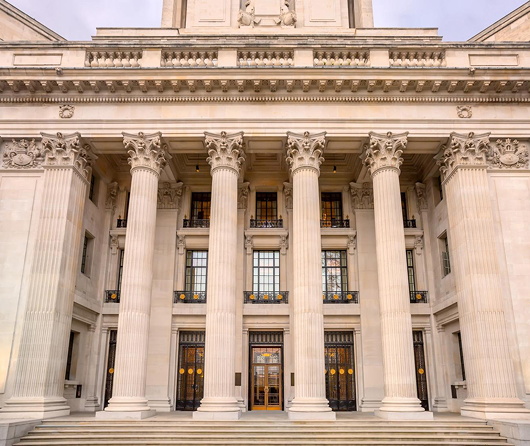
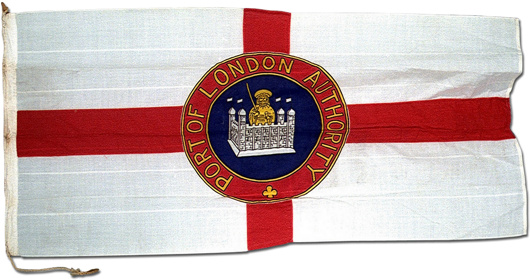
The Port of London Authority has its own flag (above) as well as its own ensign — a blue field with a Union Jack in the canton and in the fly a golden sea lion bearing a trident. Distinctive pennants also exist for the Chairman and Vice Chairman of the Authority. (These can be seen here.)
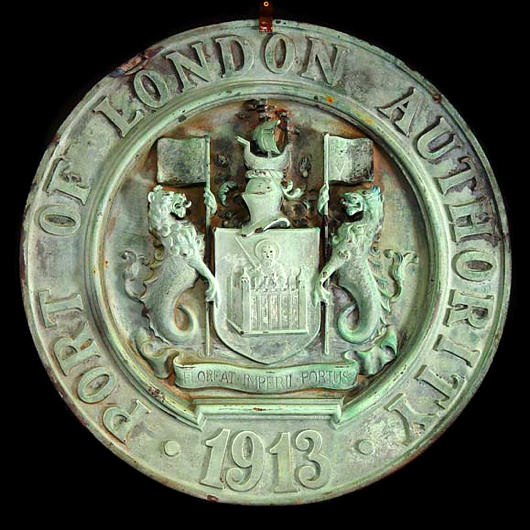
After its foundation the PLA rationalised the layout and organisation of London’s dock system, and their significant constructions allowed the Port to displays its arms on numerous buildings. One such display (above) was recently sold by Westland London.
The main shipping terminal of London is now far down-river at Tilbury and the Authority no longer owns any docks. Its duties however are still numerous — control of Thames ship traffic, navigational safety, pier & jetty maintenance, and conservation — so the century-old Authority still keeps itself quite busy looking after a millennia-old port.
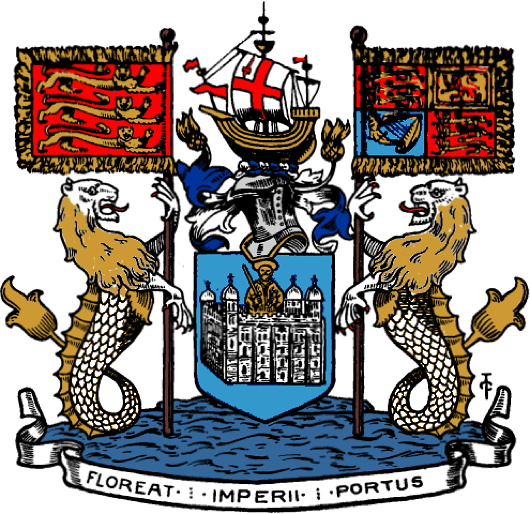
Arms of the Oudtshoorn Oratory
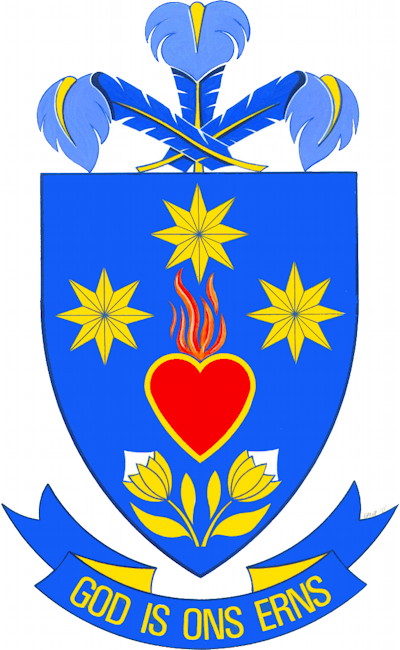
An explanation of the arms of the Afrikaans-speaking Oratory of St Philip Neri in Oudtshoorn, South Africa (edited from their own information).
The Accession
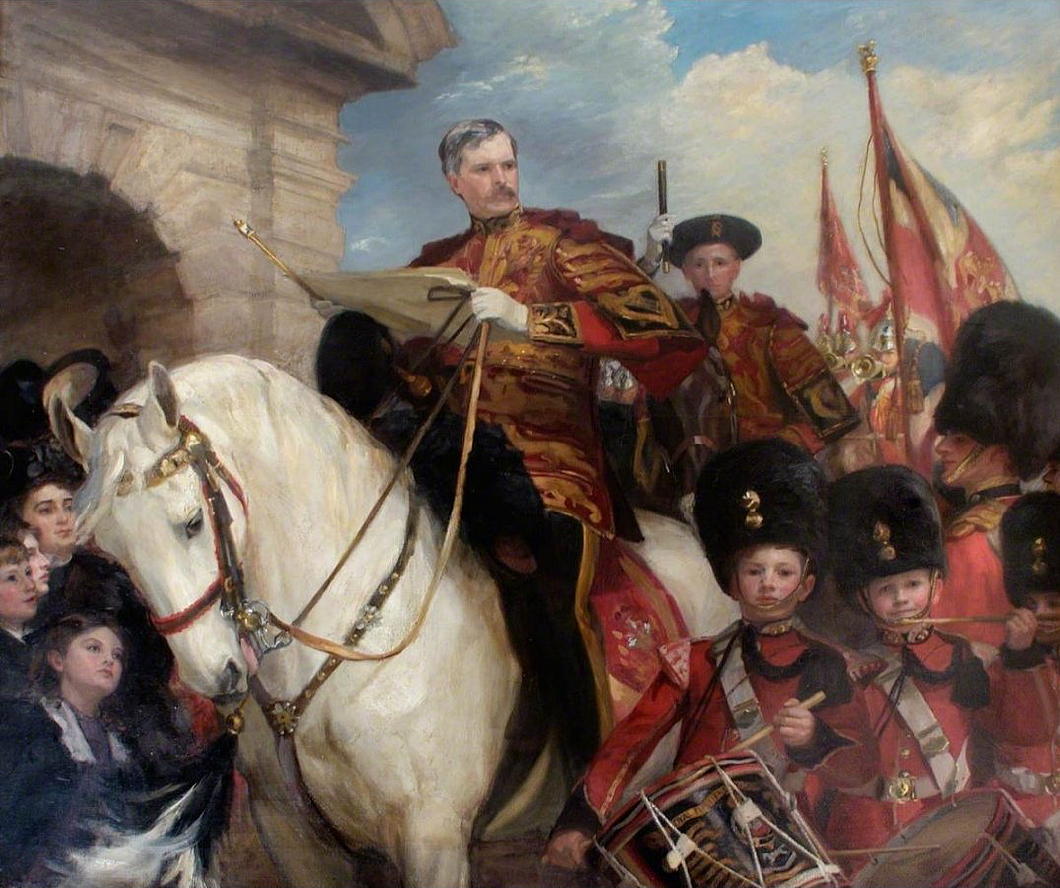
c. 1911; Oil on canvas, 68 in. x 76.9 in.
A triumphant painting, but a last hurrah. The central figure is Sir Nevile Wilkinson, the last ever Ulster King of Arms & Principal Herald of Ireland, exercising the duties of his office by proclaiming the accession of the new king at Dublin Castle.
The Anglo-Irish Treaty and its legislative acts neglected to make provision for transferring this ancient office to the new Irish Free State, but Sir Nevile carried on regardless for nearly two decades, even issuing two dozen grants of arms on the day before his death in 1940.
After his death, the Oireachtas created the office of the Chief Herald of Ireland to continue the granting of arms, and in some sense the Chief Herald is a spiritual successor to the Ulster King of Arms.
Caped Bear Cubs in Canadian Arms
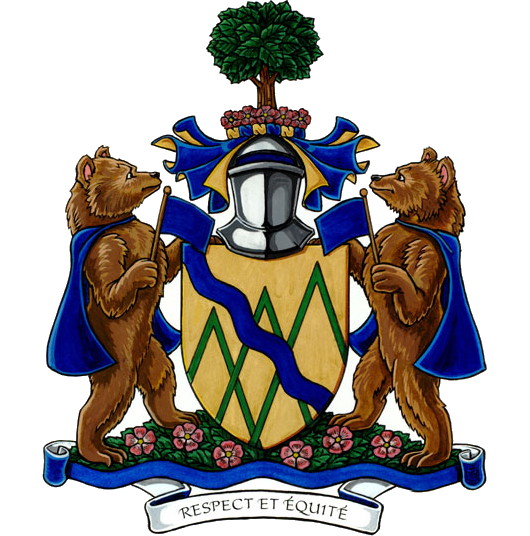
As my sister was educated (or something to that effect) by Ursulines, a recent addition to Canada’s Public Register of Arms, Flags, and Badges caught my attention. The Queen of Canada granted a coat of arms to the Quebec municipality of Sainte-Angèle-de-Mérici in 2013 (pictured above).
The shield of the arms features three chevronels represent the mountains surrounding the area while their number reminds us that Sainte-Angèle-de-Mérici is a municipality formed from two townships — Cabot and Fleuriault — and the single seigneury of Lepage-et-Thivierge. The wavy blue stripe represents the Mitis River, while gold symbolises the agricultural industry of the Sainte-Angèle-de-Mérici.
The charming aspect are the supporters: two bear cubs. St Angela Merici was the founder of the Ursulines — the Order of St Ursula — and ‘Ursula’ is Latin for ‘little female bear’.
“The bear also symbolizes bravery, thus signifying St. Angela Merici’s martyrdom,” the Canadian Heraldic Authority further explains. “The cloak is one of her traditional attributes. The flags (drapeau in French) honour Angèle Drapeau (1799-1876), the youngest daughter of Seigneur Joseph Drapeau and benefactor of the municipality.”
A Bunny Rampant
The carto-heraldic creativity of MacDonald Gill
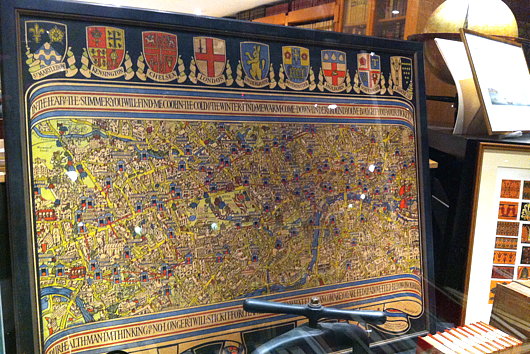
If anything, I am a lover of maps, and as a cartophile it’s a fine thing that I spend half my life in South Kensington. Here you will find two of the best antiquarian map merchants around: the Map House on Beauchamp Place and Robert Frew across from the Oratory and right next door to Orsini. Milling about in front of church after mass today I received a tip-off from a friend suggesting I have a look at the window of Robert Frew, as there was a London Underground map with coats of arms of mostly abolished boroughs.
“Sounds like the sort of thing MacDonald Gill would do,” I said, and sure enough upon investigating earlier tonight it is the work of that inventive designer (and brother of Eric Gill).
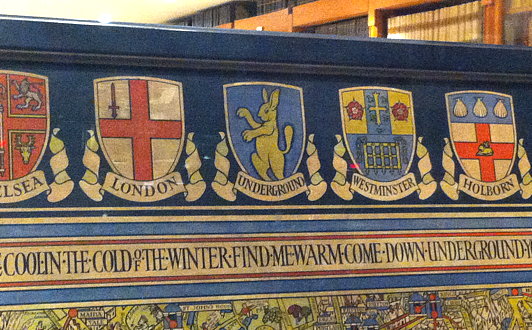
The most splendid and ridiculous aspect is that in the central place among the municipal heraldry was a putative coat of arms MacDonald Gill thought up for the Underground: a rabbit rampant. Indeed, given the twin characteristics of being speedy and digging the earth, the rabbit is a perfect animal avatar for the London Underground to adopt. Don’t go looking for this design anywhere in the rolls of Garter King of Arms, though: it’s merely the invention of the creative mind of master map-maker MacDonald Gill.
A Lecture by Andrew Cusack
College of Arms Foundation
and the
Committee on Heraldry
of the New York Genealogical & Biographical Society
cordially invite you to a talk by
ANDREW CUSACK
on

‘THREE ANNULETS OR’
THE VAN RIEBEECK ARMS
& THEIR SOUTH AFRICAN LEGACY
Tuesday 17 September 2013
at
6:00 PM
Reception to follow
New York Genealogical & Biographical Society
36 West 44th Street, 7th Floor
New York, NY 10036
Open to the public. No charge.
Please rsvp to rsvp@coaf.us to reserve a place.
As the founder of the oldest European settlement in southern Africa, he came to be seen as the father of South Africa after the country was unified in 1910. The central elements of his arms — three annulets or — obtained local, regional, and finally national significance, and influenced the design of a wide variety of South African coats of arms, many of which will be examined in this lecture.
Danzig in Flag & Arms
The first time I met my friend Rafal, I noticed his necktie bedecked with a subtle heraldic pattern. “I gather you’re German,” says young Cusack, summoning his Sherlockian deductive genius. “What makes you say that?” “The coat of arms on your tie: it’s Danzig.” “Actually I am Polish, and it’s Gdańsk!”
Well, so much for my deductive powers, (and Rafal is a secret wannabe-German anyhow) but the arms and flag of the Baltic city — once German, now Polish — combine the usual strong characteristics of any design: simplicity and beauty.
Hark, the Heralds!
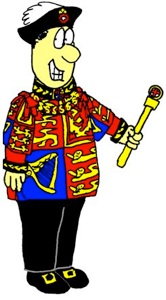
by Jack Carlson
133 pages, hardcover, $15.99
In anticipation of a party in Oriel recently, I enjoyed a pint with some friends by the fire in the King’s Arms and was given a copy of this book, mysteriously shrouded in a plastic bag. Jack Carlson’s Humorous Guide to Heraldry is a welcome addition to the Cusackian library. The author, who wrote the book when he was fourteen, is now an Oxford archaeologist (and rower) but his interests span a broad spectrum. (He is currently researching for a work on rowing blazers, a subject unjustly neglected by academics).
Aficionados of the light-hearted-guide-to-heraldry genre will notice one or two gentle riffs off of Sir Iain Moncrieffe of that Ilk’s Simple Heraldry Cheerfully Illustrated, and, since that book is long out of print, evangelists of heraldry will find A Humorous Guide to Heraldry a useful tool for introducing the uninitiated to the appreciable realms of this field. Godfathers will not want their spiritual charges to grow into adults without being able to distinguish the mêlée from the affronté and every life-long student of the world should be able to recognise a cinquefoil or a pheon.
In short: a worthy purchase for the heraldically inclined.
Jack Carlson’s A Humorous Guide to Heraldry is available here.
Pope Francis’s Arms
The Vatican released information about Pope Francis’s coat of arms on Monday but the image they provided of it was very poorly drafted. Many of us were waiting for the Italian heraldic artist Marco Foppoli to craft his own rendering of our new pope’s arms, and he has duly released it today (see above).
The central motif is the emblem of the Society of Jesus — the Christogram with nails on a sunburst. The star represents the Blessed Virgin while the sprig of nard-flower represents Saint Joseph, the patron of the universal church. Thus the three emblems on Pope Francis’s arms together represent the Holy Family.
Further info available from Il Foglio, Fr Z, and Whispers in the Loggia. (more…)
Arms of the Irish Universities
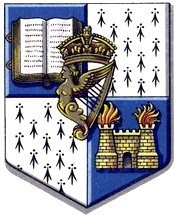 University of Dublin
University of DublinUniversitas Dublinensis; Ollscoil Átha Cliath
Dublin University was founded with the idea of creating a collegiate university along the Oxford and Cambridge model. The University of Dublin, however, failed to develop along those lines, and so its sole foundation was the College of the Holy and Undivided Trinity of Queen Elizabeth near Dublin, more commonly known as Trinity College. Strictly speaking, TCD and the university are distinct entities in law, Trinity being the only college of the university.
The university’s arms, granted in the nineteenth century, are blazoned Quarterly azure and ermine. First quarter a book open proper, bound gules, clasped or, and in fourth quarter a castle of two towers argent, flamant proper. Overall in the centre point the harp of Ireland ensigned with the royal crown. The castle with fired towers is a reference to the arms of the city of Dublin. While it is the university, not Trinity College, that awards degrees, the university arms were not used on degree certificates until 1963, when President John F. Kennedy was granted an honorary doctorate of law in St. Patrick’s Hall at Dublin Castle. (more…)
The House of Moctezuma
Noble Descendants of the Aztec Emperor
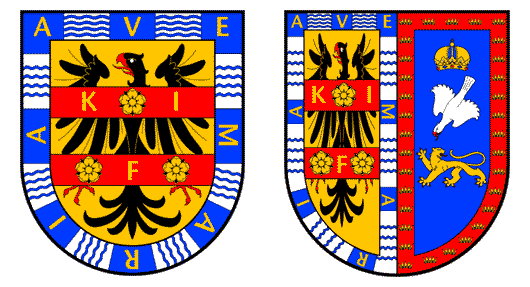
The last Emperor of the Aztecs, Moctezuma II (usually anglicised as ‘Montezuma’) suffered an ignominious end: defeated by the Spanish, some accounts have him being stoned by his former subjects, while others claim he died of starvation, refusing to eat food not worthy of an emperor, still more claim Cortés had him killed. Many of his descendants embraced Christianity and found favour from Mexico’s new overlord, the King of Spain. (more…)
Antipodean Heraldic Philately
One of my favourite series of stamps comes from New Zealand. In 1929, the New Zealand Post Office commissioned the Englishman H. L. Richardson, an artist and teacher at the Wellington Technical College, to design a series of fiscal revenue stamps, or duty stamps. The design employed the New Zealand coat of arms in a variety of colours depending on the value of the stamp. Richardson erroneously had the lion in the crest of the arms hold aloft a New Zealand flag instead of the Union Jack that he was supposed to carry. The crest was changed to a crown in 1956 (along with a series of other changes) to signify that New Zealand had by then become a sovereign realm of its own. Richardson’s stamps were withdrawn from use in 1967 when New Zealand’s currency was decimalised. (more…)
Heraldic Discrepancies in Fashion
Ralph Lauren’s Modern Field Collection
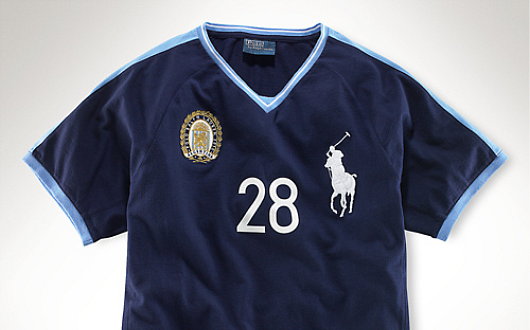
THERE IS ATTENTION to detail and then there is pedantry, and I hope this falls into the former rather than the latter. Among the numerous e-mails which find their way into my electronic postbox are occasional notifications from the Polo Ralph Lauren corporation, a multi-faceted operation involved in the design, sale, and distribution of fairly decent items of clothing. Just one such e-mail received just the other day informed me of Ralph Lauren’s new ‘Modern Field Collection’, yet another judicious tie-in to take advantageous of the patriotic (or vicariously patriotic) impulses of the consumer before, during, and after the 2010 World Cup. As someone who is interested in national and cultural symbolism, most especially heraldry, I was mildly intrigued and clicked through to find a veritable gold mine of discrepancies which I hope the reader will forgive my exposition of. (more…)
Dr. Cornelis Pama
Die grootste Suid-Afrikaanse heraldikus
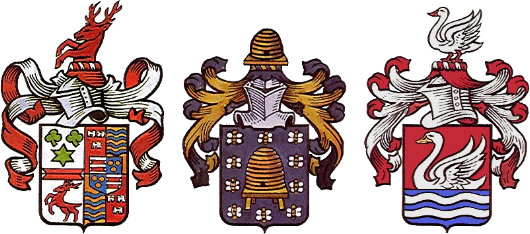
Ferreira — Bezuidenhout — Swanepoel
THE GRANDPAPA OF South African heraldry studies is undoutedly Dr. Cornelis Pama, a heraldist, genealogist, author, and editor of great importance in the field. Pama was one of the original members of the State Heraldry Council when it was founded in 1963 and refined the genealogical numbering system invented by Christoffel Coetzee de Villiers in the nineteenth century and which is now known as the de Villiers/Pama system in recognition of his contribution.
When I resume acquisitioning for my personal library, a whole slew of Pama’s works are on the ‘works sought’ list. Foremost among them is the excellent Lions and virgins: Heraldic state symbols, coats-of-arms, flags, seals and other symbols of authority in South Africa, 1487-1962 which I frequently made use of in the Stellenbosch university library.
Pama also wrote Heraldiek ABC (1980), Heraldiek in Suid-Afrika (1956), Simbole van die Unie (1960), British Families in South Africa: Their Surnames and Origins (1992), The Wine Estates of South Africa (1979), Vintage Cape Town: Historic Houses and Families In and Around the Old Cape (1973), and a history of the South African Library (the Cape Town institution which has since been foolishly merged with the Staatsbiblioteek in Pretoria to form the National Library of South Africa). The S.A.L. received his important private collection of over 800 genealogical and heraldic books and other works after Dr. Pama’s death in 1994. (more…)
Hollandic Heraldry
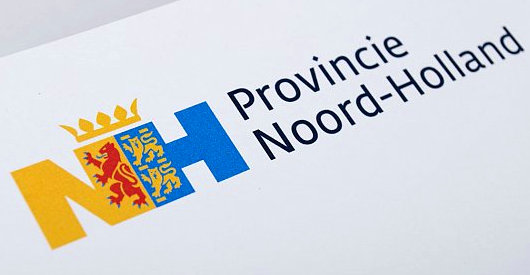
The Eden Spiekermann group, who were responsible for the redesign of The Economist in 2001, recently developed this logotype for the Dutch province of North Holland. The conjoined legs of the ‘N’ and ‘H’ integrate the province’s coat of arms.
Search
Instagram: @andcusack
Click here for my Instagram photos.Most Recent Posts
- Sag Harbor Cinema March 26, 2025
- Teutonic Takeover March 10, 2025
- Katalin Bánffy-Jelen, R.I.P. March 3, 2025
- Substack Cusackiensis March 3, 2025
- In the Courts of the Lord February 13, 2025
Most Recent Comments
Book Wishlist
Monthly Archives
Categories

